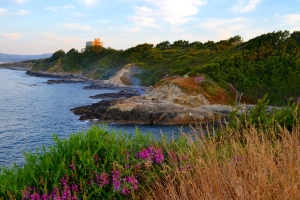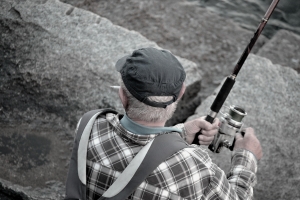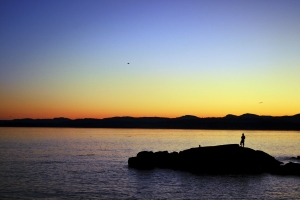What do this…
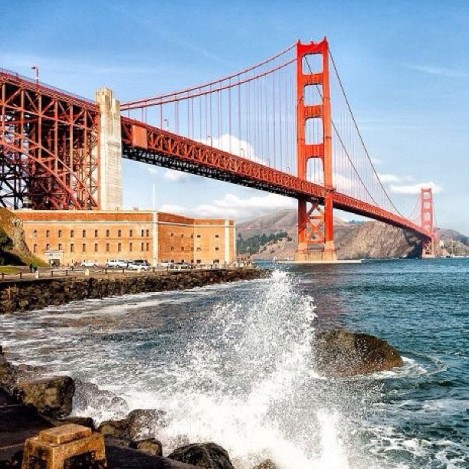
San Fran’s Golden Gate Bridge, shot by @dzeek aka Greg S. on Instagram
…and this…
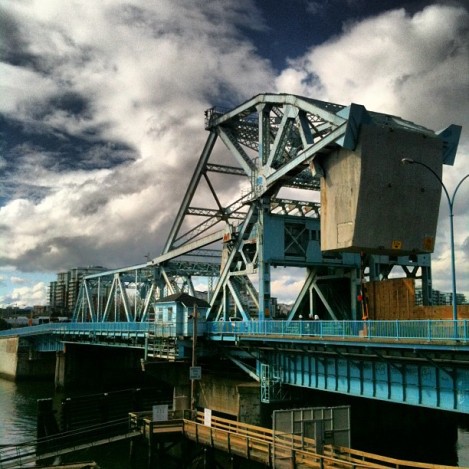
By yours truly, Victoria’s “Blue Bridge” aka The Johnson Street Bridge.
…have in common?
Answer:
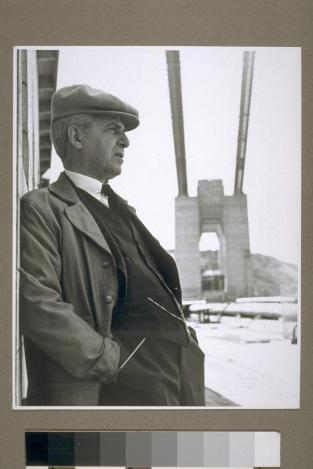
From UC Berkley’s Bancroft Library. Joseph B. Strauss, bridge mastermind, admires his handiwork.
That’s right…
Victoria’s 1924 Blue Bridge, a rare, patented overhead-counterweight version of the bascule-style bridge, was designed by the same brilliant mind behind San Francisco’s iconic Golden Gate Bridge: Joseph B. Strauss.
Unlike 1937’s Golden Gate, Victoria’s Johnson Street Bridge is not one of the “Wonders of the Modern World,” and it is also not long for this world. Instead of being preserved like so much of the heritage tends to be in Victoria, the city favours ditching the Bridge for a new sleek modern design.
Here’s a passage (albeit rife with grammatical miscues we’ll overlook) on the Johnson Street Bridge from HistoricBridges.org, who apparently, and understandably, have their panties in a twist over the genius designer’s 1924 bridge’s imminent demise:
“The Johnson Street Bridge is a rare surviving example of a Strauss bascule bridge in Canada that was actually designed by Joseph Strauss. Some bridges are “Strauss bascule bridges” by design but were not designed by Strauss himself. Additional rarity and significant arises from the fact that the bridge features an overhead counterweight. Most bascule bridges have counterweights located in a pit underneath the road. As if that were not enough significance, the Johnson Street Bridge features an extremely unusual leaf design. While the bridge is a single-leaf bascule bridge, the bridge is essentially two single-leaf bascule bridges side by side sharing a single abutment and an identical design, except that one serves a railroad line and is more narrow. As such, it is possible to raise one bridge and not the other, although obviously both bridges must be raised to allow boats to pass under. There are photos showing one half raised and the other one not available in the photo gallery. This two-bridge configuration is exceedingly rare. Another example is the Michigan Avenue Bridge in Chicago, although this is a double-lead bascule, and each of the two bridges is identical in dimensions and each bridge serves vehicular traffic, but the double-bridge concept is the same. HistoricBridges.org is unaware of another bridge quite like the Johnson Street Bridge where the two bridges are of differing width and one serves a rail line. Given the multiple levels and layers of historic and technological significance that this bridge displays, as well as the lack of a national bridge inventory listing all bridges in Canada to determine the absolute rarity of the bridge, the structure should be considered one of the most important movable bridges in Canada, a nationally significant bridge. The small numbers of surviving examples of this type of bridge in the United States suggest that it should be considered extremely rare in Canada as well. Someone came up with a count of 30 bascule bridges in Canada, but the fine print said the list was an old one and some of them might not be extant today. Therefore, that list should be discounted and the bridge should be considered more rare than that.”
It’s worth noting, of course, that the “two single-leaf bascule bridges side by side sharing a single abutment and an identical design” scenario is no more. The rail crossing was removed last year and can be seen languishing as scrap in Point Hope Shipyards.
I was told when I moved here, “Whatever you do — don’t discuss the bridge.” There was a very “shh, shh — you’ll rile people up” message given to me on a number of occasions.
It’s understating things to say there’s a massive divide in Victoria of those who want to save it, and those who’d like to see it go. Some have said to me it’s a throwback to another time, an engineering beauty, a workhorse, while others have told me it’s a rusted sieve, a life-threatening relic, and an ugly clunky thing on death’s door-step.
I am not an engineer, and when I see the Johnson Street Blue Bridge, it’s between a thing of beauty and a relic for me. A part of me would like to see it remain intact. I love heritage things, visual cues of how far we’ve come, links to our past.
These days, we build things of steel and iron, concrete and sweat, and they barely last decades now, let alone centuries, despite insane technology able to do things unthinkable even a hundred years ago. But the Ancient Romans built aqueducts that stand nearly 2,000 years later, and soon we have to tear down a bridge that isn’t a century old.
The other side of me understands why you wouldn’t want a gleaming new bridge next to this one, which would require an injection of $25 million or more to refurbish it. The bridge is likely so small it’d be hard to relocate, and its state makes it financially unfeasible to do so. And who would pay handsomely to acquire a bridge that’s admittedly in the advanced, sieve-like stages of rusting?
The civic divide is understandable.
Whatever your position, the Blue Bridge’s shelf-life looms. Reports are that, after 2016, all that will remain are the concrete pillars, since they reportedly can do nothing to move them (but which also have become manmade mini-ecosystems on their own too).
Back in 2009, the City Council claimed a new bridge would cost between $35-45 million, and would last 100 years. One might scoff at such timeline estimates when looking at the Blue Bridge today, but, realistically, it has lasted 89 years so far. Pretty good stuff… for something built shortly after WWI.
Unfortunately, the estimates for the new bridge have now ballooned as high as $93 million. Needless to say, this has further inflamed the Great Bridge Divide.
Still, both sides have valid points. Based on the design floated for approval from voters, I can see the appeal to a shiny new landmark as a symbol of the city Victoria is yearning to become — modern, at one with the nature around it. Frustratingly, murmurings have begun that not only was the original estimate inflated, but so too might the design have been. It may not resemble this sleek, elegant design, and might instead be “chunkier,” among other concessions.
In the meantime, if you’re an engineering geek, a lover of old bridges, this Blue Bridge to our past is slated to be decommissioned, and likely dismantled, by 2016, when then new bascule-style bridge is expected to be complete.
Construction begins this year on the new bridge, whose initial design is below. If nothing else, it’s certainly better-suited to the cycling/walking friendly town Victoria is.
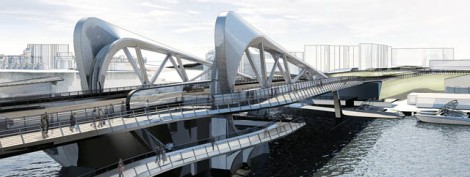
Artist’s rendition of the soon-to-be-new Johnson Street crossing.
This is one of my favourite shots I’ve seen of the Blue Bridge, from before the twin rail bridge was dismantled, found on Victoria Daily Photo.
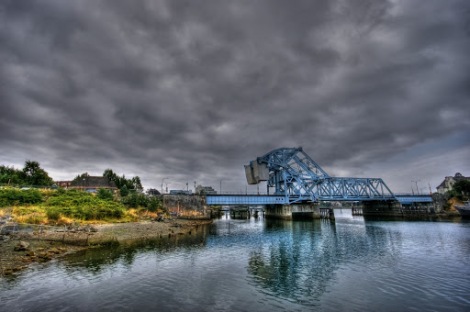
From VictoriaDailyPhoto.Blogspot.com.









